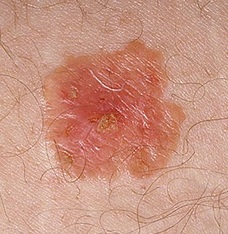Skin Cancer
Skin cancer is the most common form of cancer in the UK, with rates set to rise due to the increase use of sun beds, and availability of inexpensive package holidays. The biggest cause of skin cancer is the sun and ultraviolet (UV) radiation.
Excessive exposure to the sun, multiple instances of sunburn and the use of sun beds all lead to the development of skin cancers. In the UK, around 11,100 cases of malignant melanoma each year are linked to excessive sunlight.
At Diamond Skin Care, we know early detection saves lives. Use our guide below to spot a change in your moles.
Melanoma
 A melanoma does not necessarily cause itching, oozing, bleeding or any symptoms at all. An early melanoma often looks like an odd mole. Melanoma is the least common type of skin cancer, but the most serious. It can appear as a new mole, or a change in an existing one. Melanoma’s can appear anywhere on the body, but most often are found on the arms, face, legs and back. To help them assess a mole, most people (including doctors) use the ABCD algorithm:
A melanoma does not necessarily cause itching, oozing, bleeding or any symptoms at all. An early melanoma often looks like an odd mole. Melanoma is the least common type of skin cancer, but the most serious. It can appear as a new mole, or a change in an existing one. Melanoma’s can appear anywhere on the body, but most often are found on the arms, face, legs and back. To help them assess a mole, most people (including doctors) use the ABCD algorithm:
- Asymmetry
- Border (ragged or blurred)
- Colour (varied, black, not uniform)
- Diameter (larger than 6mm)
When caught early, a melanoma can be treated, but caught late, can be fatal. Malignant melanoma (MM) is responsible for approximately 75-80% of skin cancer deaths and the second commonest cancer in young people.
Non-Melanoma Skin Cancer
 Squamous Cell Carcinoma (SCC) is the second most common skin cancer and is also more prevalent in older people. SCC’s are uncontrolled growths of abnormal cells arising in the squamous cells, which are mainly composed of the skins upper layers. SCC’s often look like red, scaly patches, open sores, elevated growths with a central depression, or warts. These may crust or bleed.
Squamous Cell Carcinoma (SCC) is the second most common skin cancer and is also more prevalent in older people. SCC’s are uncontrolled growths of abnormal cells arising in the squamous cells, which are mainly composed of the skins upper layers. SCC’s often look like red, scaly patches, open sores, elevated growths with a central depression, or warts. These may crust or bleed.
SCC’s can occur on all areas of the body, but are most often found in areas exposed to the sun, such as rim of the ear, lower lip, face, neck, hands, arms and legs.
Basal Cell Carcinoma (BCC) is the most common skin cancer, especially in older, fair-skinned people. BCC’s are abnormal, uncontrolled growths or lesions that arise in  the skins basal cells, which line the deepest layer of the epidermis (the outermost layer of the skin). BCC’s often look like open sores, red patches, pink growths, shiny bumps or scars. BCC’s usually appear as a red or pink lump, although they can appear to have a pearly-white or “waxy” appearance, and may contain visible blood vessels.
the skins basal cells, which line the deepest layer of the epidermis (the outermost layer of the skin). BCC’s often look like open sores, red patches, pink growths, shiny bumps or scars. BCC’s usually appear as a red or pink lump, although they can appear to have a pearly-white or “waxy” appearance, and may contain visible blood vessels.
BCC’s can develop anywhere on the body, but again, usually appear on parts of the body that have been exposed to the sun. Lumps usually develop on the face, ears and neck, while the discoloured skin patches are most common on the chest and back areas of the body.
Diamond Skin Care offers a full body mole check and removals in Norwich and Colchester. The mole check service is effective and painless using an advanced technique called Dermoscopy. This technique can spot cancerous moles much earlier than previously possible, giving you peace of mind about skin cancer.
For more information please call 01603 819125, email [email protected]


